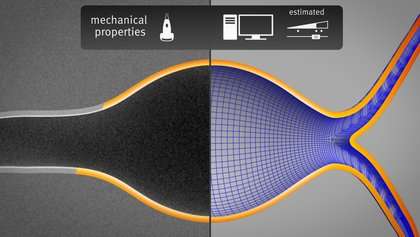Researchers develop technique to predict dangerous growth of abdominal aorta aneurysms

Eindhoven University of Technology and Catharina Hospital Eindhoven will start a major research project this month to develop techniques to predict the growth of abdominal aneurysms – large dilations of the abdominal aorta. Ruptured abdominal aneurysms are often fatal, which means patients need to be examined frequently. The new techniques will help characterize the state of the aorta. This will reduce the required frequency of examinations, which in turn will save cost. And they should also help to reduce the number of patients who suffer ruptures of the aorta in between checks.
An estimated 700,000 people in Western Europe have abdominal aneurysms. This number will continue to grow in the coming years because of population aging, and aneurysms primarily occur among older people. There were 748 fatalities in the Netherlands in 2011 through ruptures of the aorta
Current clinical practice is that doctors determine the status of an aneurysm on the basis of two dimensional ultrasound videos, which are made during patient examinations. An operation is carried out if the dilation has a diameter of 5.5 cm or more, or has grown over 1 cm in the last year. However, experience shows that some patients have much larger aneurysms without rupturing, while others experience rupture of smaller aneurysms. To investigate this problem, TU/e researcher Richard Lopata and vascular surgeon Marc van Sambeek of Catharina Hospital Eindhoven intend to develop techniques to determine the strength of the aneurysm walls of individual patients. These will allow them to predict the rate of growth of dilation of the aorta and provide the physician with model-predictive clinical decision support.
To do this they intend to make three-dimensional ultrasound videos of more than 250 patients who have regular inspections of their aneurysms. These videos already show the enlargement of the arteries, from which they can derive the stress in the vascular walls. The new technique will also allow the researchers to determine the mechanical properties of the aneurysm wall. They will also monitor the patients for four years to reach a reliable model to predict the growth of an aneurysm. To do this they will use a special 3D ultrasound system from Philips Healthcare, equipped with one of the best abdominal 3D transducers available. Lopata has made a video to clarify the research and the technique used (in Dutch):
A specially appointed PhD candidate will start work in September on the practical research. The result of the research will be 3D mechanical models of the aneurysms over time and tables that doctors can use to precisely determine when each individual patient needs to be recalled for examination. Some patients will be examined more frequently, but on balance fewer examinations will be needed. Doctors will be able to monitor the critical cases more closely, so they can respond more quickly when needed and there will be fewer unexpected ruptures.
These effects will only be achieved when the research is completed, Van Sambeek emphasizes. "So the present patients and participants in this current study won't yet benefit from it."
In time, the research may even result in the clinical situation where aneurysms are not treated at a diameter of 5.5 cm, but instead on the basis of the wall stress and mechanical behavior of the dilated of the vessel. That will make the operations much more targeted. However it will still take some time before this situation is reached, the researchers expect, because the method first needs to be thoroughly tested and validated in the lab.
















